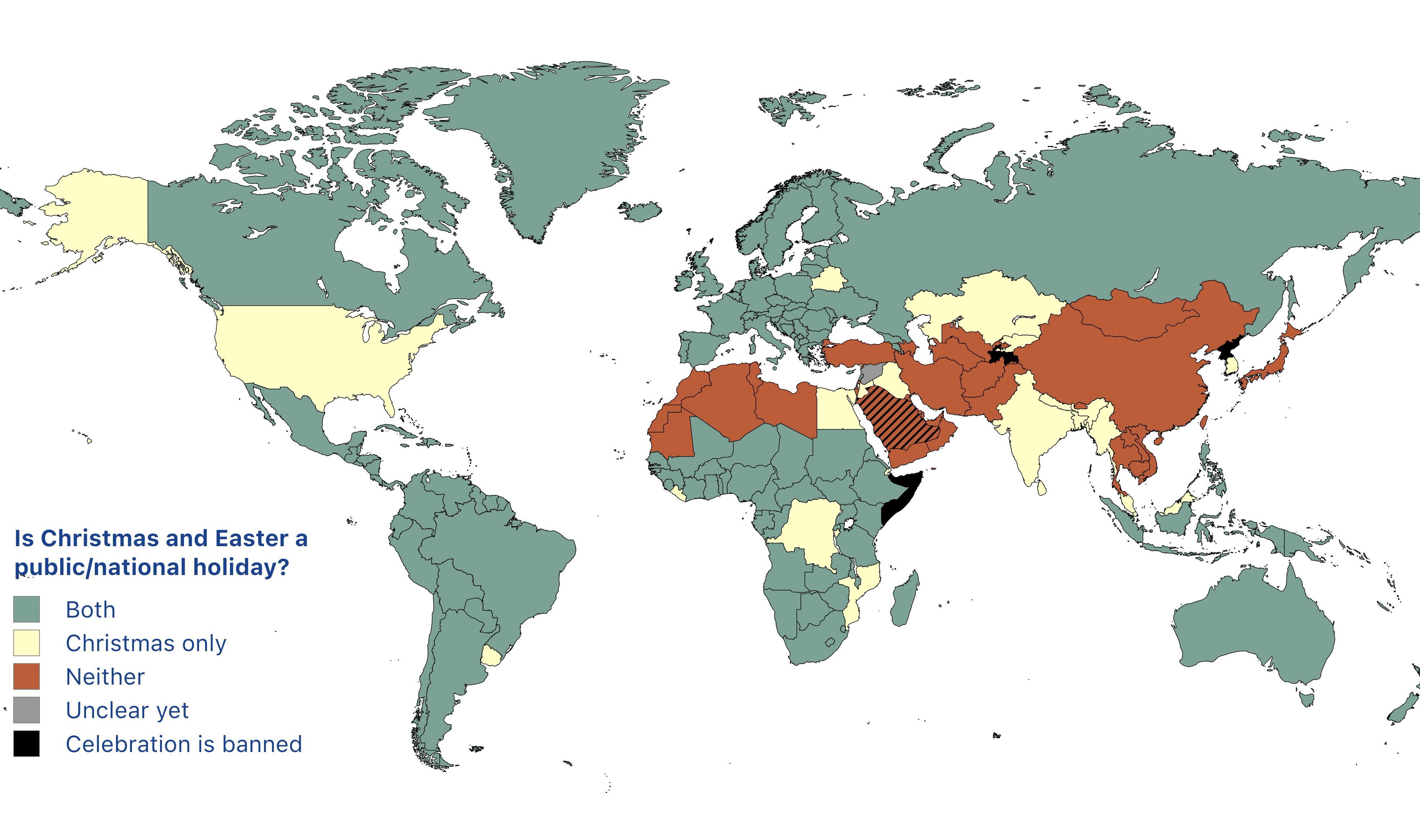Public Holidays for Christmas and Easter Map


Alex Cartwright
Senior Cartographer & GIS Specialist
Alex Cartwright is a renowned cartographer and geographic information systems specialist with over 15 years of experience in spatial analysis and data...
Geographic Analysis
What This Map Shows
The map titled "Countries where Christmas or Easter are considered public holidays" illustrates the global landscape of religious observance, particularly focusing on two of the most significant holidays in the Christian calendar. It highlights which nations officially recognize either or both Christmas and Easter as public holidays, showcasing a diverse array of cultures and traditions.
Christmas, celebrated on December 25th, commemorates the birth of Jesus Christ, while Easter marks his resurrection and is observed on different dates each year, typically in March or April. The map provides a visual representation of how these holidays are acknowledged worldwide, reflecting the varying degrees of Christian influence and the secular nature of governance in different regions.
Deep Dive into Christmas and Easter as Public Holidays
Understanding why certain countries observe Christmas and Easter as public holidays can lead us into a fascinating exploration of history, culture, and religious demographics. Interestingly, these holidays are not only significant to Christians but also play a role in the broader cultural identity of many nations. For example, in predominantly Christian countries such as Italy, Spain, and Greece, both Christmas and Easter are celebrated with extensive public festivities, including parades, family gatherings, and religious services.
In countries like the United States and Canada, Christmas is widely recognized as a public holiday, but Easter's status varies by state. This reflects a broader trend where Christmas often transcends its religious roots to become a cultural celebration that many people, regardless of their faith, partake in. In fact, studies show that nearly 90% of Americans celebrate Christmas in some form, whether religiously or secularly.
Conversely, Easter tends to be more focused on its religious significance, although it includes various cultural traditions, like egg hunts and festive meals. Countries such as Australia and New Zealand observe both holidays, but the ways in which they are celebrated can differ significantly from one region to another. For instance, in Australia, Christmas occurs during the summer, leading to BBQs and beach outings, while in Europe, it is typically associated with cold weather and winter festivities.
Interestingly, there are nations where neither holiday is officially recognized as a public holiday. In some secular states, such as those in parts of Asia and the Middle East, Christmas and Easter might be acknowledged by Christian minority communities but lack official status. This reflects a complex interaction between religion and state governance, where public holidays often align with the majority's cultural or religious practices.
Regional Analysis
When we examine the map more closely, it's clear that Europe is one of the most prominent regions where both Christmas and Easter are celebrated as public holidays. Countries like Germany, France, and the United Kingdom showcase diverse traditions surrounding these holidays, from Christmas markets to elaborate Easter feasts.
In contrast, Latin America presents a different picture. Countries such as Brazil and Argentina not only celebrate Christmas and Easter but infuse local customs into these holidays, creating a rich tapestry of cultural observance that is unique to the region.
Moving to Asia, the scenario is quite different. For instance, in the Philippines, a predominantly Catholic nation, both Christmas and Easter are national holidays, celebrated with vibrant festivals and deep religious significance. However, in countries like Indonesia and Malaysia, where Islam is the predominant faith, these Christian holidays are not recognized as public holidays, showcasing the contrast in religious practices and governmental recognition across the continent.
Furthermore, in Africa, countries like Ethiopia and Kenya celebrate both holidays, though the customs and traditions can vary widely, reflecting local cultural influences alongside religious practices. The interplay of tradition, religion, and modernity is indeed intriguing in this context.
Significance and Impact
The recognition of Christmas and Easter as public holidays carries significant implications for cultural identity, social cohesion, and economic activities. For many, these holidays provide a time for family gatherings, reflection, and community bonding. In regions where these holidays are celebrated widely, businesses often close, allowing individuals to participate in festivities, which in turn stimulates the local economy through holiday-related spending.
Moreover, understanding the status of these holidays can offer insights into broader societal values and religious landscapes. As globalization continues to influence cultural practices, it is interesting to note how the observance of these holidays may evolve. For example, as more countries become multicultural, there may be shifts in how public holidays are recognized, blending secular and religious traditions in new ways.
Looking ahead, it will be intriguing to see how the observance of Christmas and Easter evolves in the context of global changes, including shifts in demographics and the increasing influence of secularism. Will we see more countries embracing these holidays as public observances, or will a trend toward secular governance continue to rise? The map serves as a snapshot of this ongoing dialogue between tradition and modernity, reminding us of the rich tapestry of global culture.
Visualization Details
- Published
- August 10, 2025
- Views
- 120
Comments
Loading comments...